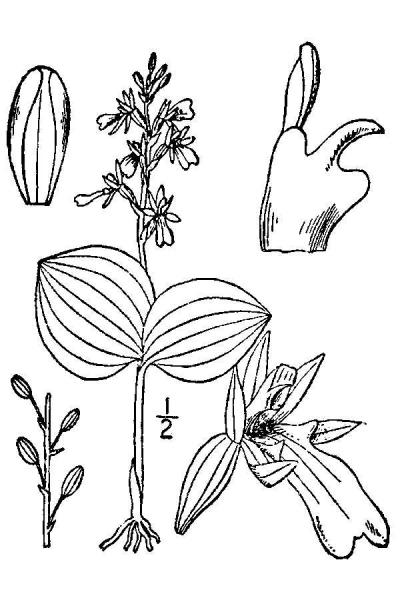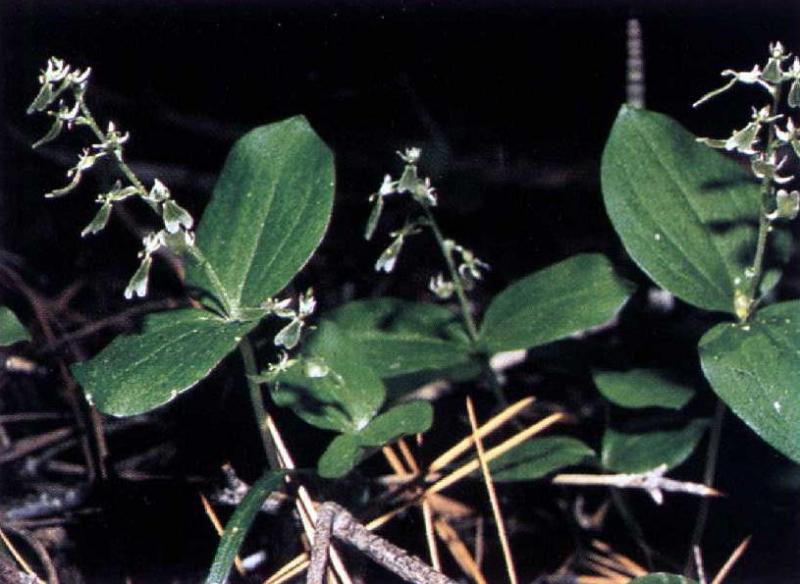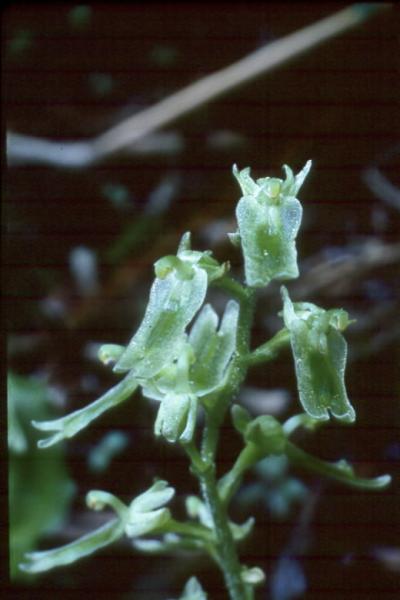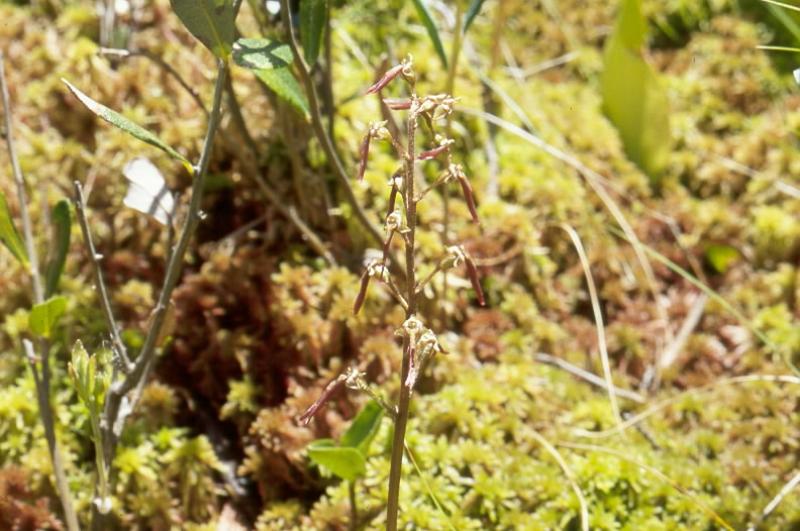Broad-lipped Twayblade
Neottia convallarioides (Swartz) Richard
- Class
- Monocotyledoneae (Monocots)
- Family
- Orchidaceae (Orchid Family)
- State Protection
- Endangered
Listed as Endangered by New York State: in imminent danger of extirpation in New York. For animals, taking, importation, transportation, or possession is prohibited, except under license or permit. For plants, removal or damage without the consent of the landowner is prohibited.
- Federal Protection
- Not Listed
- State Conservation Status Rank
- S1
Critically Imperiled in New York - Especially vulnerable to disappearing from New York due to extreme rarity or other factors; typically 5 or fewer populations or locations in New York, very few individuals, very restricted range, very few remaining acres (or miles of stream), and/or very steep declines.
- Global Conservation Status Rank
- G5
Secure globally - Common in the world; widespread and abundant (but may be rare in some parts of its range).
Summary
Did you know?
The species name comes from the resemblance of this orchid's leaves to the leaves of Lily of the Valley in the genus Convallaria (meaning a valley). A touch of the flower column triggers a squirt of a pollen-filled liquid that sticks to the pollinator insect's back. After the dust-like seeds mature and disperse they grow underground for 2-3 years before producing leaves.
State Ranking Justification
There is one known population and a second population that was reported around 1980. There have been 13 historical reports, but most of these sites have not been surveyed recently. There is a lot of additional habitat available that needs to be searched, but even if all populations were discovered this plant will likely still be considered rare in New York.
Short-term Trends
New York is at the southern edge of the range of this orchid. This orchid has always been rare in New York. Sightings are infrequent, but the habitat where this orchid is found is sometimes difficult to survey yet they are typically well-protected.
Long-term Trends
As a plant that has always been rare, a long-term assessment is difficult. The number of populations appears to be relatively stable. Targeted surveys may locate additional populations, but this small plant is difficult to find. There is plenty of suitable and high quality habitat available within the Adirondacks and Tug Hill, so there is the potential that we will find more populations over time. These populations would not necessarily indicate an increasing trend though, but reflect a better ability to locate populations that likely have been present all along.
Conservation and Management
Threats
Today there are few threats that impact this species. Run-off may have some impact, but this is not well studied. Much of the habitat where this plant might be found is either protected on public land or subject to wetland protection laws.
Conservation Strategies and Management Practices
No direct management requirements are needed for this orchid except to protect the sites where populations occur. This should include protection to any waterways that may influence the populations.
Research Needs
More research is needed on the habitat requirements so targeted surveys may be conducted. A computer distribution model may be helpful in locating new populations.
Habitat
Habitat
This orchid may be restricted to white cedar swamps in New York, particularly mossy areas on sandy soils near streams or wet depressions (New York Natural Heritage Program 2005). Rich humus in open woods to boggy meadows, soil circumneutral or at most only mildly acid, prefers cool soil (Flora of North America 2002). Wet woods, usually in deep shade (Gleason and Cronquist 1991). Especially characteristic of mossy or springy areas, seeping slopes, etc., in coniferous woods, hemlock-hardwoods, cedar swamps; often in wet sandy soil along stream borders (Voss 1972). Damp peaty or mossy glades, woods, thickets, swamps, and shores (Fernald 1970).
Associated Ecological Communities
- Hemlock-hardwood swamp*
(guide)
A swamp that occurs on mineral soils and deep muck in depressions which receive groundwater discharge. These swamps usually have a fairly closed canopy (70 to 90% cover), sparse shrub layer, and low species diversity. The tree canopy is typically dominated by eastern hemlock and co-dominated by yellow birch and red maple.
- Northern white cedar swamp
(guide)
A swamp that occurs on organic soils in cool, poorly drained depressions in central and northern New York, and along lakes and streams in the northern half of the state. These swamps are often spring-fed with continually saturated soils. Soils are often rich in calcium. The characteristic tree is northern white cedar, which makes up more than 30% of the canopy cover.
- Rich hemlock-hardwood peat swamp
(guide)
A swamp that occurs in central New York in depressions or concave slopes which receive groundwater discharge. These swamps usually have a fairly open canopy (50 to 70% cover), scattered shrubs, and a diverse groundlayer with sedges, mosses, and forbs. The characteristic canopy trees are eastern hemlock (which usually have at least 20% cover), red maple, yellow birch, black ash, tamarack, white pine, smooth serviceberry, balsam fir, and northern white cedar.
* probable association but not confirmed.
Associated Species
- Thuja occidentalis (northern white cedar, arbor vitae)
Range
New York State Distribution
This orchid appears to be restricted to the Adirondacks and Tug Hill region. More survey work is needed to determine its distribution within these areas.
Global Distribution
In eastern North America, this species ranges from Newfoundland to southern Quebec, southern Ontario, and northeastern Minnesota, south to the northern sections of Wisconsin, Michigan, New York, Vermont, and Maine. In western North America, this ranges from southern British Columbia south to the high elevations of California, Arizona, Neveda, Utah, and Colorado. It is disjunct to South Dakota and scattered locations occur in northern British Columbia and the Aleutians.
Identification Comments
General Description
Broad-lipped twayblade is only 5-10 inches tall with two, opposite, elliptic to nearly round, green leaves that are perpendicular to the stem. The stem above the leaves is whitish glandular hairy with up to 20 flowers that have a small lance-shaped leaf at the base of each flower stalk. The small green sepals and petals bend back from the dominant lip that is about 3/4" long, light green with a darker green center, narrow at the base and wide at the tip. Two shallow lobes at the tip make the lip resemble the folded wings of an insect. Sometimes there is a small tooth between the lobes. Reproduction by runners sometimes produces large colonies of plants.
Identifying Characteristics
This small orchid is 10-30 cm tall. The ovate leaves are typically 3-5 cm long, but may reach 7 cm in some individuals. The rachis (main axil of inflorescence), pedical, and ovary are glandular and hairy. There may be up to 20 flowers per inflorescence, with greenish lips. The lip is about 9-10 mm long and 5 mm wide at the summit. The lip narrows near the base and has a pair of short (often obscure) teeth. The column is 2.5-4 mm long.
Best Life Stage for Proper Identification
This plant is best identified by its flowers. Due to its rare nature though, the plant should be documented through a series of photographs. The photos should capture the overall look of the plant as well as close-up images of the flower.
Similar Species
Listera cordata and Listera australis have a lip that is cleft, with the lip having linear segments, and a column that is less than 1.5 mm long. Listera auriculata has a lip that has a broad base with lobes near the base that curve around and clasp the column. There is a known hybrid between Listera auriculata and Listera convallarioides (Listera x veltmanii) that is indeed intermediate between these two parents. This hybrid has lobes near the base of the lip, but these lobes project away from the column. This hybrid may also back-cross with either parent. The hybrid should be sought where both parents are thought to be in close proximity.
Best Time to See
This plant flowers from June to July, with fruits persisting until October. Surveys are best conducted when this plant is in flower.
- Flowering
- Fruiting
The time of year you would expect to find Broad-lipped Twayblade flowering and fruiting in New York.
Broad-lipped Twayblade Images
Images of Similar Species
Taxonomy
Broad-lipped Twayblade
Neottia convallarioides (Swartz) Richard
- Kingdom Plantae
- Phylum Anthophyta
- Class Monocotyledoneae
(Monocots)
- Order Orchidales
- Family Orchidaceae (Orchid Family)
- Order Orchidales
- Class Monocotyledoneae
(Monocots)
- Phylum Anthophyta
Synonyms
- Epipactis convallarioides Sw.
- Listera banksiana Lindl.
- Listera convallarioides (Sw.) Nutt. ex Ell.
- Listera eschscholtziana Cham. & Schl.
- Ophrys convallarioides (Sw.) W. Wight ex House
Additional Resources
Best Identification Reference
Flora of North America Editorial Committee. 2002. Flora of North America, North of Mexico. Volume 26. Magnoliophyta: Liliidae: Liliales and Orchidales. Oxford University Press, New York. 723 pp.
Other References
Britton, N. L. and A. Brown. 1913. An Illustrated Flora of the Northern United States and Canada. 3 vol. Dover Publications, Inc., N. Y. 2052 pp.
Gleason, Henry A. and A. Cronquist. 1991. Manual of Vascular Plants of Northeastern United States and Adjacent Canada. The New York Botanical Garden, Bronx, New York. 910 pp.
Holmgren, Noel. 1998. The Illustrated Companion to Gleason and Cronquist's Manual. Illustrations of the Vascular Plants of Northeastern United States and Adjacent Canada. The New York Botanical Garden, Bronx, New York.
Mitchell, Richard S. and Gordon C. Tucker. 1997. Revised Checklist of New York State Plants. Contributions to a Flora of New York State. Checklist IV. Bulletin No. 490. New York State Museum. Albany, NY. 400 pp.
New York Natural Heritage Program. 2010. Biotics database. New York Natural Heritage Program. New York State Department of Environmental Conservation. Albany, NY.
New York Natural Heritage Program. 2024. New York Natural Heritage Program Databases. Albany, NY.
Reschke, Carol. 1990. Ecological communities of New York State. New York Natural Heritage Program, New York State Department of Environmental Conservation. Latham, NY. 96 pp. plus xi.
Voss, E.G. 1972. Michigan Flora, Part I. Gymnosperms and Monocots. Cranbrook Institute of Science Bulletin 55 and the University of Michigan Herbarium. Ann Arbor. 488 pp.
Weldy, T. and D. Werier. 2010. New York flora atlas. [S.M. Landry, K.N. Campbell, and L.D. Mabe (original application development), Florida Center for Community Design and Research http://www.fccdr.usf.edu/. University of South Florida http://www.usf.edu/]. New York Flora Association http://newyork.plantatlas.usf.edu/, Albany, New York
Wiegand, Karl M. 1899. A Revision of the Genus Listera. Bulletin of the Torrey Botanical Club 26(4): 157.
William and Wilma Follette. USDA NRCS. 1992. Western wetland flora: Field office guide to plant species. West Region, Sacramento, CA.
Links
About This Guide
Information for this guide was last updated on: August 28, 2019
Please cite this page as:
New York Natural Heritage Program. 2024.
Online Conservation Guide for
Neottia convallarioides.
Available from: https://guides.nynhp.org/broad-lipped-twayblade/.
Accessed July 26, 2024.



